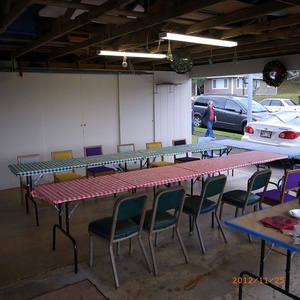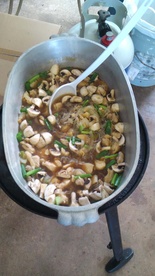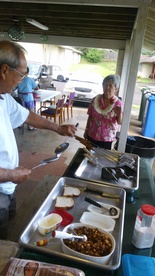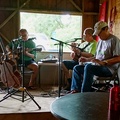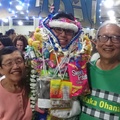I met Mr. and Mrs. M. L., a third-generation Japanese-American couple who have now become like parents to me in Hawaii, in August 2001, about two weeks before the September 11 attacks.
Shortly after, the terrorist attacks occurred. As I was planning to stay until the following year, the temporary suspension of flights had no effect on me, but the tourists gradually left and new tourists stopped coming. The lights of Waikiki faded and it became a ghost town, and the feeling of being trapped in the middle of the Pacific Ocean grew stronger day by day. It is hard to imagine a Waikiki where the shops were closed and you could not walk without a flashlight.
At that time, Mr. M invited me to a concert of the elementary school ukulele band he was coaching, saying, "The children's band will be performing at E Elementary School. Would you like to come?" It was the elementary school where his wife, Ms. L, worked. Among the many beautiful Hawaiian melodies played on the stage in the cafeteria, one song that captivated me with just the intro was "Komo mai e hea ke kanaka." The terrorist attacks occurred right at the beginning of my research until the following year, and it soothed my heart, which had been plagued by anxiety that I would not be able to observe the school as it really was.
Since then, I have become closer to Mr. M and he has started inviting me to parties at his house.
Hawaiian houses have traditionally been designed to avoid high temperatures (not as hot as Japan's recent heat, but the sun is still strong), such as having raised floors and not having beams on the ceiling. I've heard that the darker the interior, the better. However, perhaps due to the strong influence of American motorization, car life is similar to that on the mainland, with each family owning multiple cars.
Residential areas are filled with private cars on the streets. It is true that in many areas it is permitted to park on the street. It is not that the cars cannot all fit in the garage. In most cases, there is a considerable amount of space left in the garage. And yet people still park on the street at all times of the day and night. For a Japanese person like me who spends time washing and waxing my car and building a tent-type garage in an open-air parking lot, this seems like a real waste.
So what else is the garage used for besides storing cars? When I was invited to Mr. M's house, I found out. It was for parties. The first time I was invited was for Halloween in October 2001. The next was Thanksgiving in November, and I remember being invited to small family parties in between. Every time, the time just flew by as we had so much fun. Mr. M and Mr. L live together, and their garage is so small that it can barely fit two compact Japanese cars. They bring out tables and chairs from the back, line them up, and lay out cute tablecloths. They were both managers of an elementary school cafeteria, and Mr. M was the head chef of a hotel in Waikiki before that, so the food is ready in no time. It's served buffet style, and everyone takes as much as they like of whatever they like. There is always both white and brown rice. There are also several types of pickles. Simmered dishes, Kahlua pig, barbecue chicken, sukiyaki, hamburger steak, poke, garlic shrimp, poi, macaroni salad, tempura, and more.
I called this party a "garage party." Then, Ms. L burst out laughing and said, "Garage party! There's no such thing as a 'party' in this small, shabby garage." It was pronounced "Garage-Pari." I felt that there was a difference in the way I, a Japanese person, and my Japanese girlfriend perceived the word "party." When I asked her, "You don't call it a garage party?" she replied, "Well, I've never called it anything until now... No, nothing really..." When I asked her, "So what should we call this kind of party?" she said, "Well, if I had to say, it's a potluck." It seemed like she was hesitant to use the word "party." This party really didn't have a name.
The book that first drew me to Hawaii, From the Streets of Honolulu by Kato Hidetoshi, describes it this way: "A proper party invitation and a return gift are a kind of chain of obligations....So a way of holding a party that would not leave any feelings of obligation was devised: the pot luck method. In short, it is a party where everyone brings something....Above all, the dynamic between host and guest disappears, and everyone can share in the joy of 'participation.'"
It's been about 15 years since I was first invited, and dinner parties are held several times a month, mainly with relatives and friends like me. M-san and L-san's siblings and their children continue to chat lively. I don't think it's because there are researchers like me among them, but they talk endlessly about Hawaii's traditional values, life in the old days, the history and development of Japanese society, the differences and similarities with other ethnic cultures and frictions, and other topics about everyday life and history in Hawaii. The younger generation listens with gusto. There are also lots of jokes mixed in.
In this atmosphere, values such as unchanging Japanese culture in Hawaii and ever-changing Japanese culture are shared and passed on to the next generation, along with American culture. I grew up in the old rural culture of Matsuyama in Shikoku, but I have had very few opportunities to meet with my uncles and aunts recently. I am almost in my 40s, and there are many things I would like to ask my grandparents who have already passed away. I even feel a sense of crisis that I will lose my uncles and aunts without ever being able to ask them. One of my uncles passed away a few years ago at the age of 59, and my uncle-in-law passed away about 10 years ago in his 50s. Both of them were active school principals and were well versed in the history and lifestyle of the region. The opportunity to ask them such things has been lost forever.
Teacher O, whose father is of Japanese descent and mother of Okinawan descent, frequently invites me to garage parties. Every Thursday night, relatives and friends gather at his parents' house, that is, in the garage of his parents' house, and on Sunday nights, even relatives who live on other islands gather at his maternal grandmother's garage. In addition to the regular garage parties, on New Year's Eve 2001, I also went to his grandmother's house for a meal and drinks, enjoyed thousands of firecrackers, and joined him in karaoke until the morning. It is well known that Okinawans in Hawaii have a very strong bond, and garage parties are a symbol of this. Are they holding garage parties because they are so strong, or are garage parties making them stronger? It's probably both.
In Hawaii, Japanese culture and Japanese American culture are being passed down in this way as well.
So, are the garage parties at M and L's homes the same as those at O's parents' and grandmother's homes? While O's garage party was a potluck, M and L's were not. In fact, M doesn't want relatives or friends to bring anything. She tells me this every chance she gets. Her motto is, "Don't bring anything. Have fun. Eat."
By the way, the Hawaiian song that fascinated me, “Komo mai e hea ke kanaka,” which I introduced at the beginning, means “Come to my house and eat everything.” By coincidence, it’s a well-made story.
© 2015 Seiji Kawasaki



